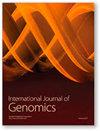Transcription Analysis of the THBS2 Gene through Regulation by Potential Noncoding Diagnostic Biomarkers and Oncogenes of Gastric Cancer in the ECM-Receptor Interaction Signaling Pathway: Integrated System Biology and Experimental Investigation
IF 2.6
4区 生物学
Q3 BIOCHEMISTRY & MOLECULAR BIOLOGY
引用次数: 0
Abstract
Background. Gastric cancer (GC) is the second most frequent cause of cancer-related death worldwide and the fourth most common malignancy. Despite significant improvements in patient survival over the past few decades, the prognosis for patients with GC remains dismal because of the high recurrence rate. In this comprehensive system biology and experimental investigation, we aimed to find new novel diagnostic biomarkers of GC through a regulatory RNA interaction network. Methods. Gene expression, coexpression, and survival analyses were performed using microarray and RNAseq datasets (analyzed by RStudio, GEPIA2, and ENCORI). RNA interaction analysis was performed using miRWalk and ENCORI online databases. Gene set enrichment analysis (GSEA) was performed to find related signaling pathways of up- and downregulated genes in the microarray dataset. Gene ontology and pathway enrichment analysis were performed by the enrichr database. Protein interaction analysis was performed by STRING online database. Validation of expression and coexpression analyses was performed using a qRT-PCR experiment. Results. Based on bioinformatics analyses, THBS2 (FC: 7.14, FDR<0.0001) has a significantly high expression in GC samples. lncRNAs BAIAP2-AS1, TSIX, and LINC01215 have RNA interaction with THBS2. BAIAP2-AS1 (FC: 1.44, FDR: 0.018), TSIX (FC: 1.34, FDR: 0.038), and LINC01215 (FC: 1.19, FDR: 0.046) have significant upregulation in GC samples. THBS2 has a significant role in the regulation of the ECM-receptor signaling pathway. miR-4677-5p has a significant RNA interaction with THBS2. The expression level of THBS2, BAIAP2-AS1, TSIX, and LINC01215 has a nonsignificant negative correlation with the survival rate of GC patients (HR: 0.28, logrank p: 0.28). qRT-PCR experiment validates mentioned bioinformatics expression analyses. BAIAP2-AS1 (AUC: 0.7136, p value: 0.0096), TSIX (AUC: 0.7456, p value: 0.0029), and LINC01215 (AUC: 0.7872, p value: 0.0005) could be acceptable diagnostic biomarkers of GC. Conclusion. BAIAP2-AS1, lncRNA LINC01215, lncRNA TSIX, and miR-4677-5p might modulate the ECM-receptor signaling pathway via regulation of THBS2 expression level, as the high-expressed noncoding RNAs in GC. Furthermore, mentioned lncRNAs could be considered potential diagnostic biomarkers of GC.通过ECM-受体相互作用信号通路中潜在的非编码诊断生物标志物和胃癌癌基因的调控分析THBS2基因的转录:综合系统生物学与实验研究
背景。胃癌(GC)是全球第二大最常见的癌症相关死亡原因,也是第四大最常见的恶性肿瘤。尽管过去几十年来患者的生存率有了明显提高,但由于复发率高,胃癌患者的预后仍然不容乐观。在这项全面的系统生物学和实验研究中,我们旨在通过调控 RNA 相互作用网络寻找新的 GC 诊断生物标志物。研究方法利用芯片和 RNAseq 数据集(由 RStudio、GEPIA2 和 ENCORI 分析)进行基因表达、共表达和生存分析。利用 miRWalk 和 ENCORI 在线数据库进行了 RNA 相互作用分析。基因组富集分析(GSEA)用于寻找微阵列数据集中上调和下调基因的相关信号通路。通过 enrichr 数据库进行基因本体和通路富集分析。蛋白质相互作用分析由 STRING 在线数据库完成。通过 qRT-PCR 实验对表达和共表达分析进行验证。结果根据生物信息学分析,THBS2(FC:7.14,FDR<0.0001)在GC样本中有显著的高表达,lncRNAs BAIAP2-AS1、TSIX和LINC01215与THBS2有RNA相互作用。BAIAP2-AS1(FC:1.44,FDR:0.018)、TSIX(FC:1.34,FDR:0.038)和 LINC01215(FC:1.19,FDR:0.046)在 GC 样本中有显著上调。miR-4677-5p 与 THBS2 有明显的 RNA 相互作用。THBS2、BAIAP2-AS1、TSIX 和 LINC01215 的表达水平与 GC 患者的生存率呈非显著负相关(HR:0.28,logrank p:0.28)。BAIAP2-AS1(AUC:0.7136,P值:0.0096)、TSIX(AUC:0.7456,P值:0.0029)和LINC01215(AUC:0.7872,P值:0.0005)可作为可接受的GC诊断生物标志物。结论作为 GC 中高表达的非编码 RNA,BAIAP2-AS1、lncRNA LINC01215、lncRNA TSIX 和 miR-4677-5p 可能会通过调节 THBS2 的表达水平来调节 ECM-受体信号通路。此外,上述 lncRNA 可被视为 GC 的潜在诊断生物标志物。
本文章由计算机程序翻译,如有差异,请以英文原文为准。
求助全文
约1分钟内获得全文
求助全文
来源期刊

International Journal of Genomics
BIOCHEMISTRY & MOLECULAR BIOLOGY-BIOTECHNOLOGY & APPLIED MICROBIOLOGY
CiteScore
5.40
自引率
0.00%
发文量
33
审稿时长
17 weeks
期刊介绍:
International Journal of Genomics is a peer-reviewed, Open Access journal that publishes research articles as well as review articles in all areas of genome-scale analysis. Topics covered by the journal include, but are not limited to: bioinformatics, clinical genomics, disease genomics, epigenomics, evolutionary genomics, functional genomics, genome engineering, and synthetic genomics.
 求助内容:
求助内容: 应助结果提醒方式:
应助结果提醒方式:


